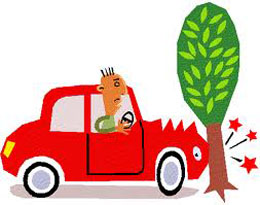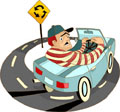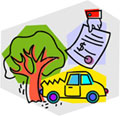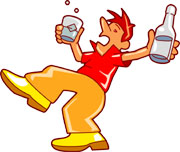
Chapter 2
Time requirement of chapter:
20 minutes
TRAFFIC CRASH PROBLEM
Driving motor vehicles is the major means of transportation in the United States. Individuals have the freedom to travel near and far. Even with all of our independence, there is a tremendous responsibility to be safe and responsible drivers.
Traffic Collisions are the leading cause of death for all individuals of every age from 4 to 33 years of age. Traffic fatalities account for more than 90% of all transportation related deaths in the United States each year. |
 |
 |
The National Highway Traffic Safety Administration has estimated the economic cost of motor vehicle crashes to be $230.6 billion annually. |
United States Crash Fact:
In 2012, crashes resulted in 33,561 fatalities. An estimated 5,338,000 police-reported motor vehicle traffic crashes resulted in 2,360,000 people injured. There were 3,957,000 property damage collisions.
 |
An average of 89 persons died each day in motor vehicle crashes in 2012. This means there was on an average one death every 16 minutes.
The economic cost to the citizens of the United States as a result of motor vehicle crashes in 2012 was $230.6 billion. These costs result from medical, property damage, loss of productivity and insurance. Motor Vehicle Accidents in the United States cost the American Society an average of $7,300 per second. |
Resource: U.S. Department of Transportation, National Highway Traffic Safety Administration, Traffic Safety Facts 2009, Overview, DOT-HS 811-856 National Center for Statistics & Analysis, 400 Seventh Street, S.W., Washington, D.C. 20590, pages 1, 2
In 2009, in the United States, there were 10,839 fatalities in alcohol-related crashes.
In 2012, 31 percent of fatal crashes in the United States involved alcohol.
In 2012, in the United States, there was an average of one alcohol-related fatality every 51 minutes.
Of the 10,322 alcohol-related fatalities in the United States in 2012, 4,104 were Passenger Vehicle Occupants, 267 were Passenger Van Occupants, 1,483 were Utility Vehicle Occupants, 1,946 were Light Truck/Pick-up truck Occupants 1,390 were Motorcycle Riders and 80 were Large Truck Occupants.
In fatal crashes in 2011, 29% of the motorcycle riders had a BAC level of .08 g/dL or higher, as compared with 21% for driver of light trucks, 24% for passenger vehicle drivers and 1% for drivers of large trucks. |
 |
Over 1.21 million drivers were arrested in the United States in 2011 for driving under the influence. This is an arrest rate of 1 for every 173 licensed drivers.
Alcohol related crashes costs society $51 billion annually, yet this conservative estimate does not include pain, suffering and lost quality of life. These indirect costs raise the alcohol related accident cost figure to a staggering $110 billion in 2012.
The cost for each injured survivor of an alcohol-related accident averages an estimated $67,000, including $6,000 in health care costs and $13,000 in lost productivity costs.
The costs to the American Society of speed-related accidents is estimated to $40.4 billion per year.
Resources: U.S. Department of Transportation, National Highway Traffic Safety Administration, Traffic Safety Facts 2012 Motor Vehicle Crashes: Over DOT HS 811-856 and 2011, Traffic Crash Facts Overview, DOT-HS 811-753, National Center for Statistics & Analysis, 400 Seventh Street, S.W., Washington, D.C. 20590, pages 1, 2, http://alcoholism.about.com/cs/alerts/l/blnaa11.htm
CRASH DYNAMICS
Absorption of Energy:
When a vehicle is moving, it is developing kinetic energy. Kinetic energy is the energy of motion. Basically, the faster a vehicle moves, the more energy of motion it is generating. Therefore, the more energy of motion their vehicle has, the more time and distance it will take the vehicle to stop. When a moving vehicle hits another object, it is called the force of impact. There are three factors that affect the force of impact. The first is the speed a vehicle is traveling, which means the greater the speed of a vehicle, the more force it will have upon impact. The second is the weight of the vehicle. The heavier a vehicle is, the more force it will have when it strikes another vehicle or object. The third factor affecting the force of impact is the distance a vehicle travels between its first impact with an object and the point where the vehicle comes to final stop. When a vehicle strikes a fixed object, the impact distance is normally short. Because the fixed object does not move much upon impact, the kinetic energy is spent immediately.
Many of today's vehicles absorb energy in a collision by the way they deform or "crush" when they are in a crash. The energy of the collision is dissipated when the metal of the vehicle deforms. Modern vehicles include a number of features which help in absorbing energy created in a crash. Vehicle manufacturers build in tempered safety-glass windows, impact resistant bumpers, protective padding on the dashboard, energy absorbing steering columns, and childproof door locks. Occupant safety devices include the safety restraint system, air bags, head rest and automatic door locks.
Today's drivers will find guardrails and sand canisters as a means to reduce impact forces. There are computer controlled traffic signals set to traffic flow patterns and pedestrian crosswalk signals.
Direction of Impact and the effect on collisions:
The direction of impact in a collision can greatly affect to severity of the injuries. Head-on collisions are the most serious type of crash. Collisions where the sides of the vehicle are struck, can also lead to serious injuries, depending on what part of the vehicle is struck and if there were any occupants in that area of the vehicle.
Resource: American Automobile Association, Responsible Driving, Chapters 7 and 13, Pages 120, 121
Scanning:
Have you ever stopped to think about the number of distractions you experience both inside and outside your vehicle as you are driving? The National Highway Traffic Administration has concluded that ninety-nine percent of all traffic collisions are due to driver error. By continuously scanning the roadway, a driver can identify potential hazards and take the necessary action in time to avoid a collision. The best method for scanning depends on the area where the vehicle is being operated.
While driving in a metropolitan area a driver will encounter numerous intersections and crossing traffic. There may be detours, irregular traffic lanes and possible road defects. There will be other roadways users such as pedestrians, bicyclists and emergency vehicles. There are more sight obstructions and normally heavier traffic.
With these thoughts in mind, here are some important ways to scan the roadways when driving in a city.
Utilize these tips for scanning when driving in the country.
- Activate the vehicles low-beam headlights even in the daylight.
- Scan 20 to 30 seconds ahead or up to the next hill or curve.
- Scan for objects in the roadway or to the side of the road that are12 to 15 seconds ahead and start taking immediate action.
- Always obey the posted speed limit.
- Maintain the proper following distance from any vehicle ahead.
- Always activate the vehicle turn signals before changing any lane, stopping, or passing.
There are some drivers who believe traveling on the interstates is much easier than driving in the country or cites and therefore let their guard down. They do not pay as much attention to the driving task. This can be a very dangerous decision.
Here are some tips for driving on interstates:
- Scan 20 to 30 seconds ahead and pay attention to vehicles not only on your side of the highway, but also to the vehicles traveling in the opposite direction.
- Check the review and outside mirrors approximately every 5 to 10 seconds.
- Pay special attention when approaching exits and entrances.
- Always activate the vehicle turn signals when changing lanes.
- Turn on the vehicle's headlights.
- Watch the vehicles ahead, not just the vehicle in front, and start to react early, if there is a potential hazard.
- Always maintain the recommended following distance.
- Stay out of the "No Zone" of large vehicles.
Resource: www.dmv.ca.gov/pubs/hdbk/pgs33thru41.htm, scanning
Adaption to Surroundings:
The following are some areas of concern for mature drivers. Special attention and focus on driving is needed in these areas to prevent collisions, injuries and death.
- Residential areas
- Around playgrounds
- In areas of schools
- Hospital zones
- Construction zones
Pedestrians, especially children, may be distracted and not paying attention to roadway traffic. Drivers must be extra cautious when driving in these areas and slow down.
Effects of Aging on Perceptual Ability:
As we age, our perceptual abilities decrease. Age can affect the following:
- Slowed body functions, thought process and reflexes
- Increased visual impairment
- Decreased acuity at night
- Likelihood of over the counter drugs or medications being present and multiplication of side effects
Planning a Trip:
- Be aware of your physical health and limitations
- Make sure to plan for medical conditions requiring special dietary needs
- Have an adequate amount of medication available
- Keep track of times for medication(s)
- Be familiar with side effects of medication(s)
WEATHER CONDITIONS FOR TIME OF YEAR AND AREA:
- Be familiar with adverse weather conditions, and how to safety maneuver in those conditions
a. Slowdown in rain, snow and fog
b. Check weather before leaving
c. Make smooth starts and stops
- Have additional equipment available for adverse conditions where you are travelling
a. Blankets
b. Extra clothes
c. Water and food
d. Lights
e. Candles for warmth
f. Shovels and salt
- Consider postponing trip if adverse weather conditions are anticipated
- Be familiar with the type of weather you may expect for your local area.
Consider the possibility of fog, rain, snow and dust storms.
All these can have a dramatic effect on the driving environment.
TYPE OF VEHICLE AND CONDITION:
- Have the vehicle serviced before the trip
- Become familiar with a vehicle before you use it
- Have safety equipment checked before the trip
- Plan on taking emergency spare parts if travelling in unpopulated areas or in adverse weather
- Purchase vehicles that provide comfort and are easy to maneuver and allow for proper mobility.
Sports cars might not be a good choice for senior drivers.
LONG TRIPS IN UNFAMILIAR AREAS:
- Obtain up-to-date maps to plan the route
- Be familiar with alternative routes in case primary routes are closed or inaccessible
- Try to avoid using a route with potentially hazardous terrain
- Attempt to become familiar with condition and maintenance of the roadways on your route
- Select routes that may be longer, but present less hazards and unfamiliar traffic congestion
- Check anticipated weather conditions and plan to have appropriate safety equipment with you
- Attempt to become familiar with intrastate traffic laws and restrictions
GENERAL FACTORS FOR AVOIDING FATIGUE ON LONG TRIPS:
- Set realistic goals for daily mileage
- Determine the time of day you want to travel to avoid congested traffic conditions
- Avoid driving from dawn to dusk
- Do not take stimulants to stay awake
- Make room reservations in advance with late arrival guarantee to avoid rushing
- Get a good night's sleep before starting out
- Eat lightly but regularly
- Take periodic rest stops
- Share the driving whenever possible
PLANNING FOR DAILY TRIPS
- Make sure your vehicle is equipped with appropriate driving aids for physical limitations
- Take medications as directed and at specified intervals
- Avoid driving from dusk to dawn
- Do not drive if not feeling well
ROAD CONDITIONS:
- Choose a familiar route, freeway versus city street
- Avoid poorly maintained or unmarked roadways
- Avoid congested areas
TRAFFIC CONDITIONS:
- Commute hours vs. non-commute
Choose the time of day to avoid congested and unfamiliar conditions
- Be familiar with local traffic conditions which may affect the driving environment and your driver performance.
Consider rush-hour traffic conditions, construction zones, and weather and roadway conditions.
WEATHER CONDITIONS:
Do not drive in unfamiliar or adverse weather conditions .
VEHICLE MAINTENANCE:
- Have your vehicle periodically serviced by authorized mechanics
- Periodically check safety equipment
Following Distance:
Many mature drivers still use the concept of one car length for every ten miles per hour of speed their vehicle is traveling. This concept has been replaced with the 3 second rule. However, the 3 second rule is the minimum standard and a better rule to follow is the 4 second plus rule.
To utilize the 3 second rule, choose a fixed object near or above the road ahead, like a sign, tree, or an overpass. As soon as the rear end of the vehicle ahead of you passes your fixed reference point, begin counting: one-thousand one, one-thousand two and one-thousand three.
When the front of your vehicle passes the reference point, stop counting. If you reach the reference point before you have finished the three-second count, you are following too close.
If you finish the count before you reach the reference point, you have established a following distance that provides a safe following distance.
Resource: www.smartmotorist.com/traffic-and-safety-guidelines/maintain-a-safe-following-distance-the-3-second-rule.html, www.edmunds.com/ownership/driving/articles/438101/article.html
The three-second rule is designed to be used during clear weather, level roadways, and when following cars and light trucks. When there are poor environmental conditions; when following large vehicles or motorcycles; or when towing a trailer, additional seconds are needed to provide an adequate space cushion.
Dealing with Tailgaters:
The safest solution when being followed too closely, is to yield to the other driver. Slower traffic should move to the farthest right lane. If you cannot yield, then leave more room in front of your vehicle to allow for safe stopping distances for you and the tailgater behind you. Try to encourage a tailgating driver to overtake if it is safe to do so. Slow slightly below the normal flow of traffic speed. This allows the tailgater more room to pass, and your slower speed makes it easier for him to do so. It also allows more room in front of your vehicle to stop safely if required. If safe to do so, pull off the side of the road and let the tailgater pass. If a tailgater persists in following your vehicle, travel to the nearest law enforcement agency and request assistance in dealing with the tailgating driver.
Resource: http://en.wikipedia.org/wiki/Tailgating, http://en.wikipedia.org/wiki/Tailgating
Stopping Distance in Relationship to Speed:
Perception time is the amount of time it takes for a driver to realize there is a need to react to a situation. Perception time can only be estimated, as it is different for each incident depending on what the driver was doing before they realized there was a need to react.
Reaction time is the amount of time from the perception of an immediate hazard to the actual attempt to complete an evasive maneuver. Initial driver reaction time is on average approximately three quarters of a second.
The average human reaction time of three quarters of a second is based on a laboratory setting where the driver is prepared and waiting for the measurement of reaction time. In actual emergency driving situations, a driver's actual reaction time may be more than three quarters of a second.
Actual reaction time of an average driver is approximately 1.5 seconds during daylight and 2.5 seconds at night.
A vehicle travelling at 60 mph covers 88 feet per second. But stopping that vehicle takes over 4.5 seconds and covers a distance of 271 feet. Why? Because there's more involved in braking than the actual time a vehicle's brakes are applied to the wheels (called "effective braking"). In particular, "perception time" and "reaction time" add considerable distance to stopping your car.
Let's say for instance, the perception time is an average of three-quarters of a second. Then the reaction time is an additional three-quarters of a second. When you combine perception and reaction time, a full 132 feet will pass before a vehicle even begins to slow down from 60 mph. So from the time a driver perceives a braking situation until the time their vehicle comes to a complete stop, a total of 4.6 seconds elapses. During that time the vehicle travels a total of more than 270 feet. That's almost the length of a football field. Of course, the faster a vehicle is traveling, the more time and distance it will take to stop.
There are other factors as well, such as road conditions. When there are adverse weather conditions, braking distance grows exponentially. On wet pavement, total braking time increases from 4.6 seconds to 6.1 seconds, and total braking distance shoots up from 271 feet to 333 feet. And it gets worse. In snowy conditions, even with snow tires, total stopping time jumps to 10.6 seconds and 533 feet. As a basis of comparison, this is roughly the same distance as the same vehicle coming to a complete stop from 90 mph on dry pavement, an effective doubling of the braking distance.
The greater the speed of a vehicle, the greater will be the distance required to bring the vehicle to a complete stop. Remember large vehicles take longer to stop, so increase your following distance to allow yourself more time to react. Motorcycles operators when attempting to stop in an emergency situation may lose control of their motorcycle, so increase your vehicle following distance when driving behind motorcycles.
Resource: www.howtodothings.com/automotive/a3255-how-to-calculate-your-braking-distance.html, www.safespeed.org.uk/tailgate.htm, www.edmunds.com/ownership/driving/articles/438101/article.html
Gap Selection:
Turning right and accelerating to 30mph takes about six seconds. Turning left and accelerating to 30mph takes about seven seconds. A gap is the distance between vehicles. You must be able to judge the gaps between vehicles and how long it takes to pass through or enter intersecting traffic.
When you enter a street after stopping, you must judge the size of the gaps in the on-coming traffic. The same procedure to judge following distance is adapted to judge gap sizes. Crossing an intersection takes four to five seconds from a stop. If traffic on the through street is traveling 30mph, you need a gap of about two-thirds of a block in each direction.
You will need a larger gap to join traffic when turning right than when crossing. You need about six seconds to reach the speed of through-street traffic without interfering with the flow of traffic. A left turn is more dangerous than a right turn.
This is because you cross paths of traffic from the left before entering traffic from the right. The gap to the left should be larger than when making a right turn.
At 50 mph, you need a gap of more than three and one-half blocks.
RISKS TO SOBER DRIVERS FROM IMPAIRED DRIVERS:
Costs per Alcohol-Related or Substance-Related Injury
The average alcohol-related or substance-related fatality in the United States costs $3.5 million to the survivors of the person killed.
- $1.1 million in monetary costs
- $2.4 million in quality of life losses
The estimated cost per injured survivor of an alcohol-related crash averaged $99,000
- $49,000 in monetary costs
- $50,000 in quality of life losses
|
 |
Crash Costs per Mile Driven in the United States averaged:
- $5.80 per mile driven at BACs of .10 and above
- $2.50 per mile driven at BACs between .08-.09
- $0.10 per mile driven at BACs of .00
Costs per Drink
The societal costs of alcohol-related crashes in the United States averages $1.00 per drink consumed. People other than the drinking driver paid $0.60 per drink.
Impact on Auto Insurance Rates
Alcohol and substance related crashes account for an estimated 18% of the $103 billion in annual U.S. auto insurance payments. |
 |
Resources:National Highway and Traffic Safety Administration. Economic Impact of Motor Vehicle Crashes 2000.Summary. Retrieved On January 28, 20003 from the World Wide Web: http://www.nhtsa.dot.gov/people/economic/econimpact2000/summary.htm, National Highway and Traffic Safety Administration. Economic Impact of Motor Vehicle Crashes 2000. State Costs. Retrieved On January 28, 20003 from the World Wide Web: http://www.nhtsa.dot.gov/people/economic/econimpact2000/state_costs.htm
National Cost of a DUI - Driving Under the Influence
Getting a DUI is obviously a horrible idea. What you might not realize, though, is how expensive it is. It varies from situation to situation, and state to state, but you can guarantee it will take a big chunk out of your annual budget. According to people who know (lawyers, police and Auto clubs), the average costs (not including any costs for lost pay, personal injuries, medical costs, vehicle damage or additional penalties for causing a crash while impaired) for a first offense driving under the influence case are:
- Minimum fine: $ 390
- Penalty Assessment: $ 666
- State Restitution Fund: $ 100
- Alcohol-Abuse Education Fund: $ 50
- Blood or Breath-Testing Fee: $ 37
- Jail Cite-and-Release Fee: $ 10
- Driving/Alcohol-Awareness School: $ 375 (12 weeks minimum)
- License Reissue Fee: $ 100
- Attorney Fees (average): $ 2,500
- Auto Insurance Increase: $ 3,600 - $6,600
(The Auto Club estimates $2,200 a year for 3 years)
- Total $7,828 - $10,8281
|
 |
Resources:Mothers Against Drunk Driving. Drinking and Driving is Very, Very Expensive!. Retrieved on February 1, 2009 from the World Wide Web: http://www.maddorangecounty.org/cost.htm
CHAPTER 2 QUIZ
| Question 1 |
Traffic Collisions are the leading cause of death for all individuals of every age from 4 to 33 years of age.
|
| Question 2 |
Traffic fatalities account for more than ___% of all transportation related deaths in the United States each year.
|
| Question 3 |
An average of ___ persons died each day in motor vehicle crashes in 2012.
|
You have reached the end of this chapter.
Once the timer below reaches zero the button on the bottom right hand side of the screen will be activated allowing you to continue with the course.








